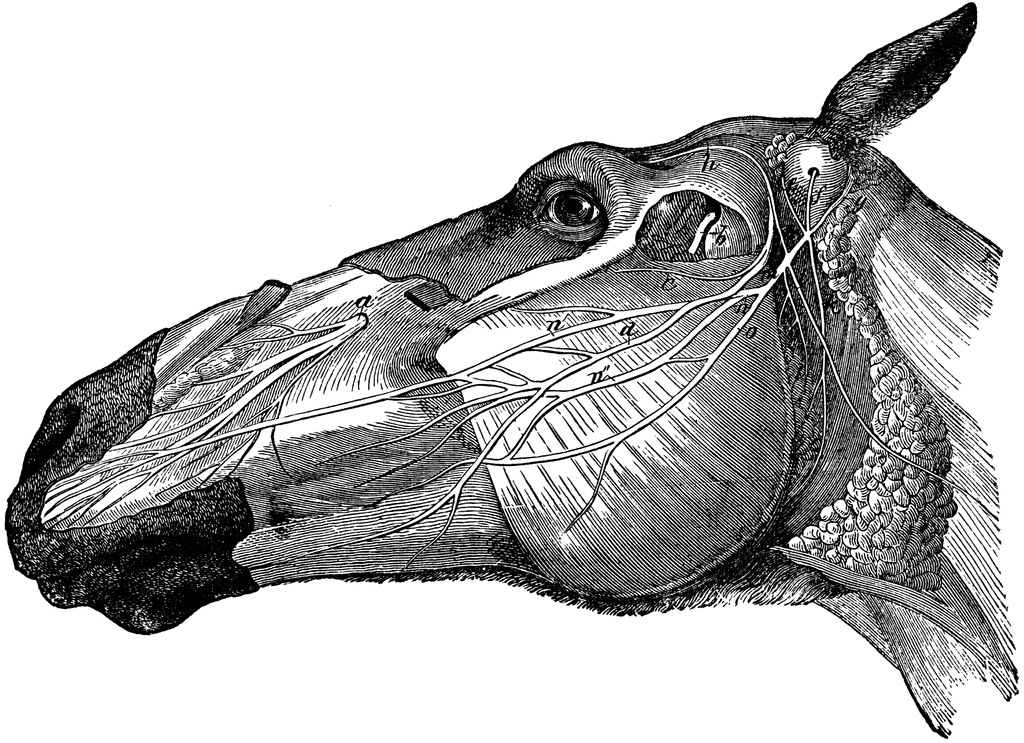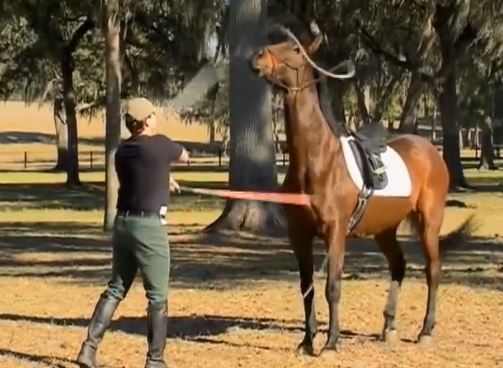One of my pet peeves that I see routinely done by people handling horses is what in some circles is known as “shanking.” This is not to be confused with another practice referred to as shanking, which involves putting a chain over a very aggressive horse’s nose to add some “bite” to the noseband of the halter when the horse pulls. That technique is often used for handling stallions, and can have a place with proper use for certain horses.
There is another type of “shanking” that involves yanking on a horse’s nose when the horse is wearing a halter. An extreme form of it is often seen in Arabian halter classes, where it is used to make the horses more animated.
While many people would agree this seems unkind, this practice is actually commonplace even in natural horsemanship circles. What you see in the video appears worse because the horses in the video are halter bred Arabians, many of which by breeding have a hot, reactive personality. As I’ve mentioned in other blog posts, reactive horses often highlight which horse handling practices are cruel, because they respond dramatically to things which horses naturally find alarming, frightening or unfair. It is my belief that just because a Quarter Horse or other stock horse might stand and allow shanking without leaping backwards or rearing like an Arabian, that doesn’t mean they find the action comfortable or kind.
Shanking is widely used as a disciplinary tool. If a horse doesn’t stand still, steps into a handler’s comfort zone, or spooks while being led, many handlers have learned that it is an acceptable practice to “shank” the horse, or yank very hard on the lead rope underneath the horse’s chin. They will often repeat the yanking several times in a row.
From what I’ve observed, many horses find shanking to be excessive and unfair. First, the handler’s hand is usually underneath the horse’s chin where the horse cannot see it. From the horse’s perspective, the pain they feel on their face comes with no warning. Because the pain often takes the horse by surprise, the horse will usually stiffen their body, arch their back and a reactive horse might even rear or back up suddenly.
If a person were to use shanking as a disciplinary tool, it seems that in order to be fair to the horse, they would have to follow some steps that I’ve never actually witnessed by someone utilizing this method. First, the horse would have to understand they were doing something wrong. Has the horse been taught already that they must always stand still in this certain situation? Have they been consistently shown that this certain defined space belongs to the handler and they are not allowed to enter it? Or, as is more common, is the horse allowed to come in, fawn over the handler, perhaps rub on the handler, except for other situations when the handler suddenly shanks the horse for “entering his space”? How is the horse supposed to understand that in these five cases he’s allowed to come into your space but in these other cases he is not? If a horse does not wish for another horse to come into his space, he will warn the other horse with body language. When we shank a horse, we are in effect, “lighting into” the horse without warning.
At certain times, horses are allowed into each others’ personal space
Secondly, if the horse has been taught a concept such as “stand,” or “back up,” then he should be given the opportunity to demonstrate the behavior. Instead of yanking on the horse for not standing still, why wouldn’t the handler first give the command to “stand?” Instead, what I see happen constantly is this: The horse does the behavior the handler doesn’t like. The handler “shanks” the horse with no warning. The horse reacts, making the behavior even worse. This causes the handler to then say, “Stand,” or “Back up!,” usually while shanking the horse more, and usually harder than before, as if more pain will make the situation improve.
In my opinion, shanking a horse is similar to a mother with a child who instead of telling the child what he was doing wrong or warning him would just slap him in the face. Then if the child reacted to the slap, the mother would slap him several more times. For some reason we would understand this is cruel and might cause emotional damage to a child, yet treat our horses like this.
There are other concerns with shanking as well.

There are lots of nerves on the horse’s face, all of which can potentially be damaged. Damage to the facial nerves can cause neuralgia. Trigeminal nerve neuralgia causes sharp pains and shock-like sensations to a horse’s face, often triggered by wind pressure on the damaged nerve. Some horses that have sustained facial nerve damage exhibit behavioral issues and some can’t be ridden because as they head into a breeze, the neuralgia causes pain and they may suddenly rear or bolt in response. Trigeminal neuralgia has also been linked to chronic headshakers.

Look at the above pictures of where the facial nerves are and then look at your typical rope halter and see where the knots are placed. For some reason, many people believe that because rope halters seem more “natural,” and are advocated by natural horsemanship trainers, that they are somehow more kind. In reality, rope halters are thinner than nylon halters (more pressure on smaller areas of the face), and less likely to break in an emergency. They offer more control than nylon halters due to concentrated areas of pressure from the knots around the nose that press on the facial nerves. Now why don’t we start yanking on it too?

If you’ve ever seen a horse pull back in a nylon halter, it is frightening. However, even though the horse may get facial abrasions, the metal buckles will eventually give in to the force the horse exerts and the halter will break. A rope halter will not break. Some people do not want a halter to be able to break, but my belief is it is always better for a horse to get loose rather than continuing to pull back and damage the atlas of their neck, falling and twisting, or continuing to panic.
Several times, I have seen the practice of shanking cause harm to horses. In the first case, a sensitive Arabian was not standing still for a farrier. The farrier stood up and shanked the horse several times. The horse immediately backed up about 15 steps, running into the side of a building and cutting his leg on a piece of metal.
Another time, I saw a horse step toward the handler, get shanked, and rear straight up in the air. The horse slipped, frightening himself even more, and this episode caused a behavioral issue where if the horse felt pressure on his nose he would panic and rear. It took some time to convince the horse that being led was a safe situation. I would not want to be there if someone tried to shank this horse hard again.
Along with shanking, many handlers use a method where they follow up the shanking with making the horse back up rapidly. Often they will smack the lead rope back and forth underneath the horse’s chin. On one occasion, I saw the buckle come undone and fly up and hit the horse in the eye due to the handler’s rope swinging. How is this natural or kind to horses?
I don’t understand why people feel they must back a horse from 5 feet away nowadays. Back in the day when I was taught how to handle horses, most people would back the horse while standing in front and slightly to the left side. It is not a difficult skill for horses to learn. Those who practice a lot with their horses can teach the horse to back up a step every time they stop when being led.

Contrast this horse’s posture with the horse below, being backed up by the swinging rope in the face method:

It is my belief that the top horse is learning, while the bottom horse is merely reacting.
I don’t shank horses. If a horse demonstrates behavior I dislike, I will either circle the horse, make them stop and stand, or back the horse up. None of these corrections require swinging the rope around the horse’s face or yanking on the horse’s halter. I was taught that a horse’s head is delicate and focusing corrections on it can make a horse head shy. Unless a horse bites you and you also have perfect timing, the head is off limits for corrections. If a horse is not physically attacking you, there is no reason why a correction must be fast and aggressively aimed at the horse. Patience and calmness always reap more rewards than impatience, and I believe that shanking becomes a habit for many handlers that they will often resort to without thinking through a situation.
Why a person would ever shank a horse after the horse spooks is beyond me. A spooking horse feels insecure, so adding pain or harsh correction to the situation will only make the horse more excited, not more calm. For the horses’ sakes, please avoid yanking and shanking and instead try communicating with the horse. Do not punish the horse because you haven’t been clear about what you want from him, or for exhibiting natural behaviors such as spooking.
